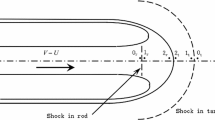Abstract
We present a brief survey of the influence of the dynamic behavior of materials on the stationary penetration of long rods into thick plates at elevated velocities. Our attention is mainly focused on the analysis of the influence of the resistance of the material to plastic flow, strain rate, temperature effects, compressibility, and the boundaries of interacting bodies on the process of penetration. We also formulate basic directions of subsequent investigations.
Similar content being viewed by others
References
V. G. Alekseevskii, “On the problem of penetration of a rod into a target at high velocities”,Fiz. Goreniya Vzryva, No. 2, 99–107 (1996).
A. Tate, “A theory for the deceleration of long rods after impact”,J. Mech. Phys. Solids,15, 387–399 (1967).
A. Tate, “Further results in the theory of long rod penetration”,J. Mech. Phys. Solids,17, 141–150 (1969).
S. J. Bless, W. Gooch, S. Satapathy, J. Compas, and M. Lee, “Penetration resistance of titanium and ultra-hard steel at elevated velocities”,Int. J. Impact Eng. (1998).
W. P. Walters and B. R. Scott, “The crater radial growth rate under ballistic impact conditions”,Comput. Struct.,20, No. 1-3, 641–648 (1985).
V. S. Kozlov, “A model of penetration taking into account the viscous properties of colliding bodies”,Probl. Prochn., No. 3, 47–52 (1986).
A. V. Agafonov, “The role of viscosity in the process of subsonic penetration of solid bodies into isotropic targets”,Prikl. Mekh. Tekh. Fiz., No. 3, 120–125 (1986).
V. V. Kharchenko,Effect of High Loading Rates on the Resistance of Materials and Structural Members to Deformation [in Russian], Author's Abstract of the Candidate Degree Thesis (Technical Sciences), Kiev (1987).
W. P. Walters, W. J. Files and P. C. Chop, “A survey of shaped-charge jet penetration models”,Int. J. Impact Eng.,7, No. 3, 307–325 (1988).
G. V. Stepanov and É. G. Safarov, “Resistance to penetration of a conic rod into an classtoplastic medium”,Probl. Prochn. No. 4, 69–74 (1990).
G. V. Stepanov, “Analysis of the depth of penetration of a rigid ball into a massive target”,Probl. Prochn., No. 3, 67–69 (1969).
P. H. Pidsley, “A numerical study of long rod impact into large targets”,J. Mech. Phys. Solids,32, No. 4, 315–333 (1984).
H. G. Hopkins, “Dynamic expansion of spherical cavities in metal”, in: I. N. Sneddon and R. Hill (editors),Progress in Solid Mechanics, Vol. 1, North-Holland, Amsterdam-New York (1960), pp. 84–164.
R. F. Bishop, R. Hill and N. F. Mott, “The theory of indentation and hardness tests”,Proc. Phys. Soc.,57, Pt. 3, 147–159 (1945).
M. J. Forrestal, K. Okajima and V. K. Luk, “Penetration of 6061-T651 aluminum targets with rigid long rods”,Trans. AMSE, J. Appl. Mech.,55, 755–760 (1988).
J. D. Walker and C. E. Anderson, Jr., “A time-dependent model for long-rod penetration”, in: Proc. of the 13th Army Symposium on Solid Mechanics (Plymouth, August 1993), Plymouth (1993), pp. 271–282.
R. C. Batra, “Steady-state penetration of viscoplastic targets”,Int. J. Eng. Sci.,25, No. 9, 1131–1141 (1987).
C. E. Anderson, Jr., S. A. Mullin, and C. J. Kuhlman, “Computer simulation of strain-rate effects in replica scale model penetration experiments”,Int. J. Impact Eng.,13, No. 1, 35–52 (1993).
G. V. Stepanov and V. V. Kharchenko, “Distinctive features of deformation of metals at strain rates higher than 104s−1”,Probl. Prochn. No. 8, 59–64 (1985).
G. V. Stepanov,Elastoplastic Deformation and Fracture of Materials under Impulsive Loading [in Russian], Naukova Dumka, Kiev (1991).
G. Weirauch and H. F. Lehr, “Experimental studies on terminal ballistics of kinetic energy projectiles”, in: Proc. of the 3rd Internat. Symposium on Ballistics, H2, Karlsruhe (1977), pp. 1–12.
J. M. Krafft, “Surface friction in ballistic penetration”,J. Appl. Phys.,26, No. 10, 1248–1253 (1955).
A. L. Wingrove, “The forces for projectile penetration of aluminum”,J. Phys. D: Appl. Phys.,5, 1294–1303 (1972).
R. C. Batra, “Steady-state penetration of thermoviscoplastic targets”,Comput. Mech.,3, No. 1, 1–12 (1988).
S. Hanagud and B. Ross, “Large deformation, deep penetration theory for a compressible strain-hardening target material”,AIAA J. 9, No. 5, 905–911 (1971).
R. C. Batra and T. Gobinath, “Steady-state penetration of compressible rigid perfectly palstic targets”,Int. J. Eng. Sci.,26, No. 7, 741–751 (1988).
G. V. Stepanov and V. I. Zubov, “Analysis of the forces of resistance of an aluminum alloy to penetration of a steel cylinder with velocities lower than 450 m/s”,Probl. Prochn., No. 5 (1998).
Additional information
Institute for Problems of Strength, National Academy of Sciences of Ukraine, Kiev, Ukraine. Translated from Problemy Prochnosti, No. 4, pp. 39–51, July–August, 1998.
Rights and permissions
About this article
Cite this article
Stepanov, G.V., Kharchenko, V.V. Influence of the dynamic behavior of materials on the penetration of long rods at elevated velocities. Discussion. Strength Mater 30, 383–392 (1998). https://doi.org/10.1007/BF02524713
Received:
Issue Date:
DOI: https://doi.org/10.1007/BF02524713




